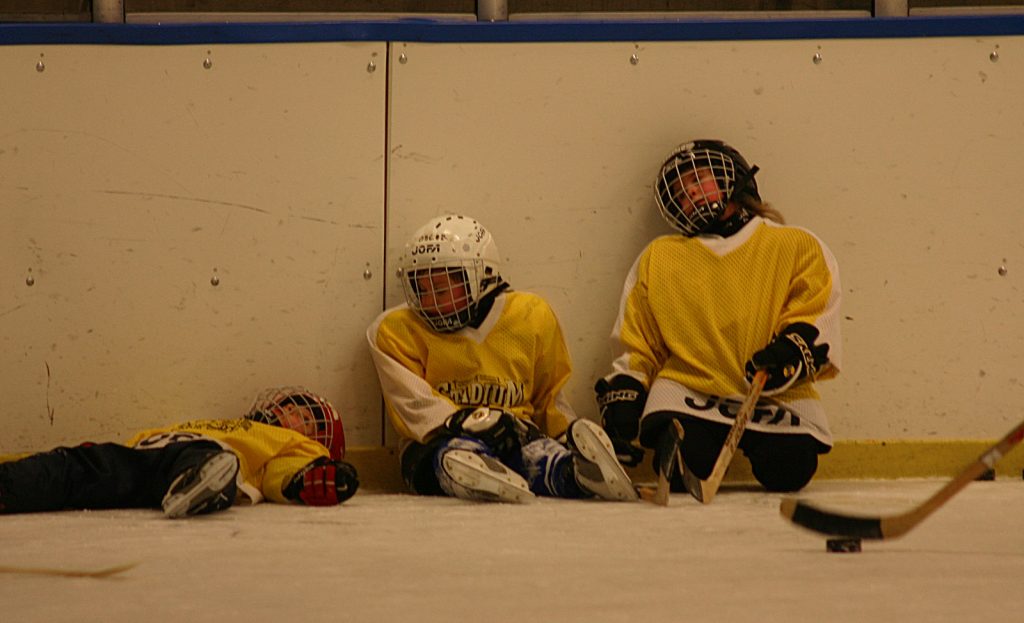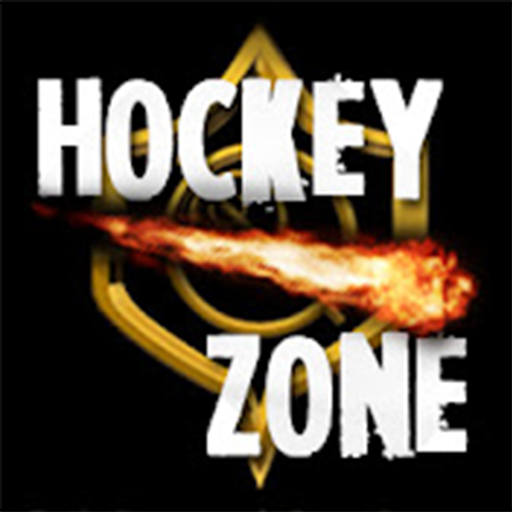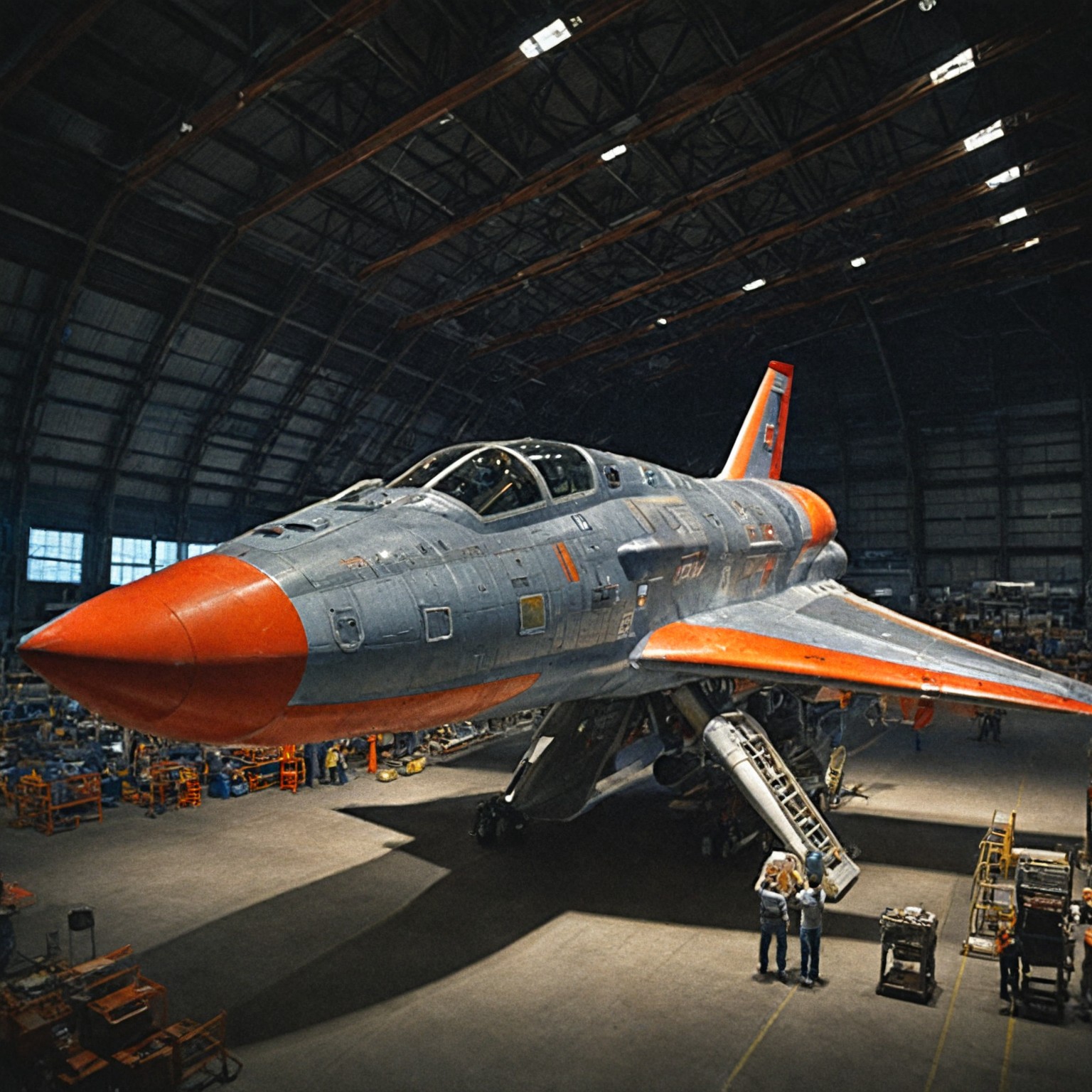Welcome to the second edition of Hockey Zone Under The Hood, exploring how ship settings work in detail and how they have changed over time.
Your ship’s Energy can be spent on four areas:
- Afterburners (what we colloquially call thrusting)
- Slapshots
- Firing bullets
- Absorbing damage from enemy bullets (duds)
A ship’s Energy is defined in the settings as InitialEnergy. As with a lot of the settings, the highest it can be theoretically set to is 32,767 (215 -1).
Other than for Beer League’s “nerfbird“, we don’t use greens or prizes in Hockey Zone, so MaximumEnergy only changes the appearance of the weapons gauge. (If fiddling with the ship settings, care must be taken that MaximumEnergy is greater than or equal to InitialEnergy otherwise the “Maximum” value will be used instead, and this applies similarly for other settings like Rotation and Recharge.)
Energy by ship:
 Warbird: 190
Warbird: 190 Javelin: 651
Javelin: 651 Spider: 400
Spider: 400 Leviathan: 695
Leviathan: 695 Terrier: 390
Terrier: 390 Weasel: 385
Weasel: 385 /
/  Goalies: 2200
Goalies: 2200
For the skater ships, InitialEnergy has only had minor tweaks over time.
The goalies’ InitialEnergy has seen huge changes, and not just because of the old archetypes of “large prox lancaster” vs “fast shark”. These changes have sometimes been suddenly between seasons, not gradually over time. Goalie Energy has been as low as 1800 and as high as 4000.
Every aspect of how energy is handled is customized between ships, so one unit of Energy for a warbird is not similar to one unit of Energy for a leviathan. Even the damage taken from the same level bullet varies from ship to ship. This means using Energy as a comparison for different actions is pointless, so for the rest of this article I will be converting Energy cost into the time taken to recover the lost Energy for an action.
Recharge
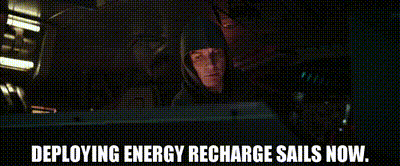
The rate your ship recovers Energy is defined by InitialRecharge. Its units in the settings represents the Energy recovered in 10 seconds. Your ship is constantly recharging at this rate unless you are at full Energy.
Like with InitialEnergy, the skater ships’ values for InitialRecharge have only seen small tweaks.
Other than when it was heavily nerfed in Season 33, the leviathan‘s Recharge has gotten steadily stronger.
The javelin‘s Recharge has been nerfed a few times, including for this season.
One point of comparison between ships is the “Recharge time”, which is the time taken to go from no energy back to full strength:
Recharge time (seconds) = InitialEnergy * 10 / InitialRecharge
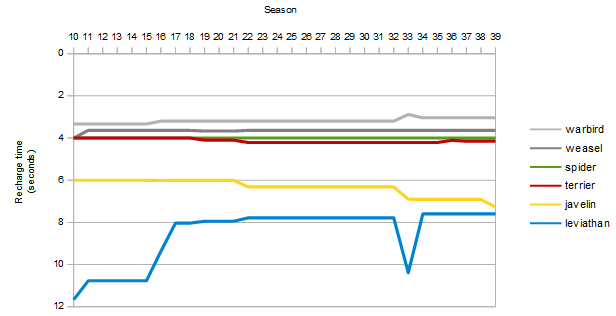
The goalies‘ InitialRecharge has varied a lot, and not in proportion to the changes to InitialEnergy, leading to very large changes in Recharge times between some seasons. The goalie settings have varied so greatly that they deserve their own in depth article.
Afterburners
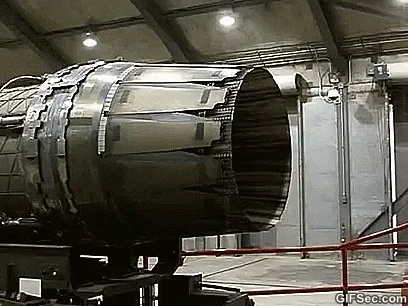
Using Afterburners is explained in the first Hockey Zone Under The Hood article.
It costs Energy to use Afterburners, and this is defined in the settings as AfterburnerEnergy. It is in the same units as InitialRecharge (i.e. Energy lost in 10 seconds of use).
While you are are using Afterburners, you lose Energy at the rate defined by AfterburnerEnergy, but simultaneously gain it back at the rate defined by InitialRecharge, giving a net loss.
We can define “Discharge time” as the time taken to go from full Energy to no Energy while using Afterburners:
Discharge time (seconds) = InitialEnergy * 10 /(AfterburnerEnergy – InitialRecharge)
Discharge time varies less between skater ships than Recharge time:
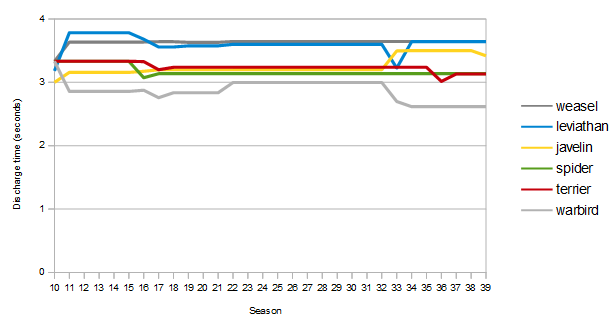
The warbird has the fastest Discharge time, but it also recovers the fastest.
What we can then look at is the proportion of time thrusting compared to recharging. It’s not quite an apples to apples comparison between ships: as explained in the first HZ Under The Hood Article, while the relative bonus to top speed is similar, some ships get a larger bonus to acceleration while using Afterburners.
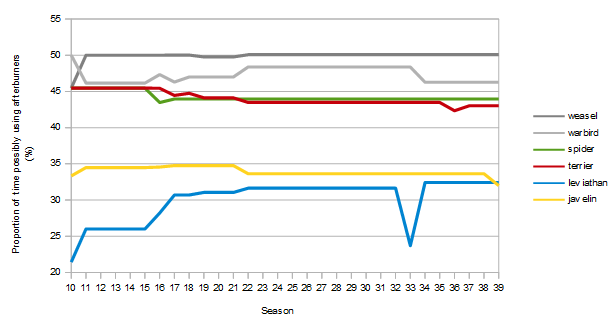
The weasel can spend more time using Afterburners than other ships, and has exactly equal Recharge time and Discharge time.
The heavy nerf to the leviathan in Season 33 stands out, and could go some way to explaining why its usage dropped off that season to only 4.7% in the regular season and barely used at all in the playoffs.
This season’s recharge nerf for the javelin means it can now use its Afterburners least out of the skater ships.
Slapshot cost
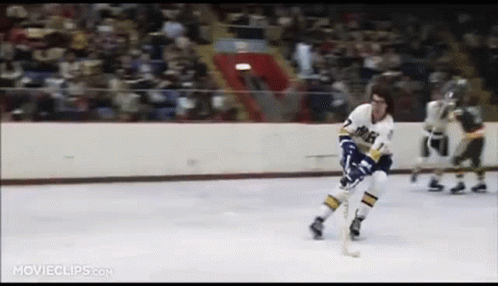
Slapshots and One-Timers were introduced in Season 16, and can be performed by skater ships with the bomb key (Tab by default). This fires the powerball at a faster speed than the normal shot.
How Slapshots work will be looked at in detail in a future article, but today we will compare the Energy cost for using Slapshot. This is defined in the settings by BombFireEnergy.
The Slapshot cost is usually set at between 75% and 85% of each ship’s InitialEnergy, but for this season the leviathan‘s Slapshot cost was increased to over 90% of its InitialEnergy with the intention of preventing the leviathan from being able to use Slapshot soon after firing a bullet.
The practical cost in terms of time to recover for using Slapshot hasn’t changed much since Season 22:
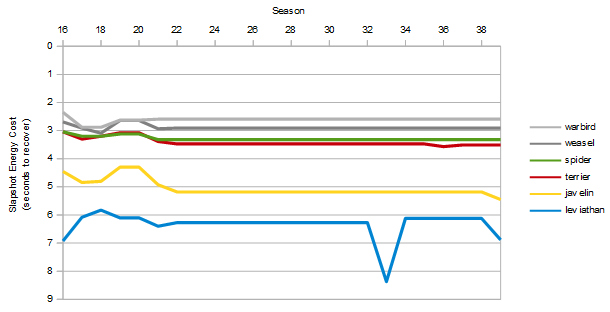
The leviathan has the largest bonus for using Slapshot compared to its normal shot speed, but with a recovery time of nearly 7 seconds, it had better use this prudently.
Droppass was also introduced in Season 16, and for its inaugural season cost 20% of the ship’s InitialEnergy to use. This is set by LandMineFireEnergy, and the cost was removed for Season 17 onwards.
Bullet cost

The cost to fire bullet(s) is BulletFireEnergy multiplied by InitialGuns. Double barrel bullets don’t cost extra (e.g. javelin).
Bullets will be looked at in detail in future HZ Under The Hood articles. InitialGuns used to affect the damage the bullets could cause, but this changed in Season 16. Since then, other than acting as a multiplier to bullet cost, InitialGuns only affects the sound your own ship makes (as some of you have been exploring during the recent Big E pub nights).
The time to recover the Energy lost for firing a bullet hasn’t changed much since Season 17, except for Season 33 where one-off nerfs to the javelin and leviathan stand out:
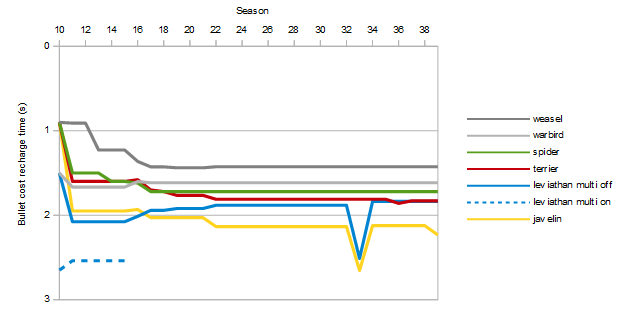
The weasel and warbird recover the Energy lost from firing a bullet the fastest, but their bullets inflict less damage than other ships.
Multifire cost
Multifire bullets (currently used by leviathan and lancaster) have a separate cost in the settings: MultiFireEnergy multiplied by InitialGuns.
Multifire bullets used to cost more than normal bullets, but now match the normal bullet cost:
- Lancaster Multifire was changed to match the normal bullet cost in Season 34. The only reason to not use Multifire in a lancaster would be the risk of one of the side bullets hitting a ship which wasn’t the intended target, resulting in the bullet being shielded. (As soon as one of the bullets from a salvo hits an enemy, all of the bullets disappear.)
- As mentioned at the end of the recent blog article “Ship Settings Not As Advertised“, the shark still has Multifire available, but it appears as only one bullet. During most of Season 32, its value for MultiFireEnergy was wrongly set, resulting in the bullet costing 54% more for no gain if Multifire was activated.
- The leviathan‘s Multifire was removed for Season 16. When it was brought back in Season 34, it cost the same as a normal bullet; the only difference compared to a normal bullet is the fire rate.
Damage profile
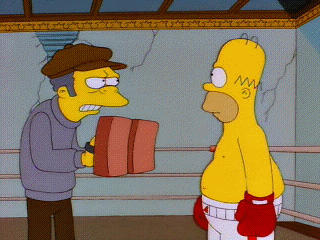
A “dud” is where the damage from a bullet isn’t high enough to kill the ship. This is different to a “tank” which is caused by lag.
Before Season 16, bullets could cause any amount of damage from as low as 1 up to a maximum limit, allowing any ship to randomly get a dud.
Since Season 16, Hockey Zone has used ExactDamage where a certain Level of bullet will cause a defined amount of damage.
There are four Bullet Levels.
- Warbird and weasel can fire Levels 1 to 3 (what we colloquially call the Level 1 ships).
- Spider and terrier can fire any of the 4 Levels (what we colloquially call the Level 2 “Christmas” ships).
- Javelin and leviathan fire Level 2 to 4 (what we colloquially call the Level 3 ships).
- Goalies only fire Level 4’s.
Which Level you fire from this range is semi-random, and how this works will be looked at in a future article.
Three settings decide how much damage each Bullet Level causes:
- BulletDamageLevel gives the damage for a Level 1 bullet without the ball.
- BulletDamageUpgrade is the difference between each subsequent Bullet Level without the ball.
(i.e. a Level 2 bullet causes BulletDamageLevel + BulletDamageUpgrade damage;
a Level 3 bullet BulletDamageLevel + 2*BulletDamageUpgrade;
a Level 4 bullet BulletDamageLevel + 3*BulletDamageUpgrade.) - FlaggerDamagePercent acts as a multiplier so that more damage is taken with the ball than without. Despite being called “percent”, its units in the settings are actually “permille”.
So a Level 3 “On Ball” Bullet Level would be calculated as:
(BulletDamageLevel + 2*BulletDamageUpgrade) * FlaggerDamagePercent/1000
When exact damage was introduced in Season 16, each ship had the same settings for BulletDamageLevel, BulletDamageUpgrade and FlaggerDamagePercent, but this was customized by ship from Season 17.
Warbirds and goalies suffer more damage than normal, with all three settings values higher than the default.
For the warbird, I assume this was to make it more likely to die with the ball to any bullet. However, before Season 33 the warbird‘s InitialEnergy was still higher than the damage inflicted by the customized Level 1 bullet, allowing it to potentially dud with the ball.
The custom damage profile makes it easier to bully the warbird off the ball, as it takes about 15% more damage than normal.
Goalies take about 9% more damage than the default. I don’t know what the thinking behind that would be.
The javelin and leviathan take less damage than normal from Level 1 bullets, but more damage than normal from Level 3 and Level 4 bullets. I assume this was originally to do with making sure they die with the ball to a Level 4 bullet, but giving them an armor effect against the weaker ships. (There is also an Armor setting used just by the javelin and leviathan, but this affects the bullet Levels rolled against them, not directly the damage taken.)
A warbird with the ball will die to any bullet. It only takes two Level 3 bullets to kill them without the ball (or a Level 2 bullet and a Level 4 bullet).
The spider, terrier and weasel can dud a Level 1 or 2 bullet, but will always die to a Level 3 or 4 bullet with the ball. (This is how a warbird can occasionally surprise kill these ships even if they have full Energy.)
The javelin and leviathan can dud a Level 1, 2 or 3 bullet, but will die to a Level 4 bullet with the ball.
The goalie Energy is only slightly higher than the damage caused by three Level 4 bullets. This means a goalie out of the crease is always at risk from being pummeled by a full strength leviathan even if they don’t use Afterburners: a leviathan can fire four times from full Energy and these bullets are likely to be Level 4’s.
I am curious as to why ships were given custom damage profiles rather than directly adjusting their Energy.
Beer league’s nerfbird
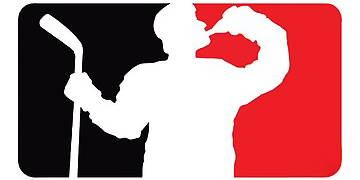
Beer league has two versions of the warbird: the standard warbird with settings mostly the same as RSHL, and the nerfbird for supervets.
The nerfbird‘s acceleration and speed cap is about 20% lower than its normal counterpart. This only applies when not using Afterburners; they have the same acceleration and speed cap with Afterburners.
The nerfbird‘s Energy is only 165, rather than the normal 190 and it also recharges 32% slower.
The Energy related nerfs help indirectly slow the nerfbird down in addition to the Speed and Thrust nerfs, as it has to spend more time recharging without Afterburners.
The nerfbird can only use Afterburners a maximum of 31% of the time compared to 46% for the normal warbird.
The nerfbird removes the need for the nightwasp, which was used in earlier beer league seasons as the supervet ship. ![]()
The nightwasp was a nerfed ship that replaced one of the normal skater ships.
In Season 6 of Beer League, the nightwasp replaced the javelin, and when first testing the ship there was confusion over how it was able to dud some bullets. It had inadvertently inherited the javelin‘s custom Damage profile.
Ideas to explore
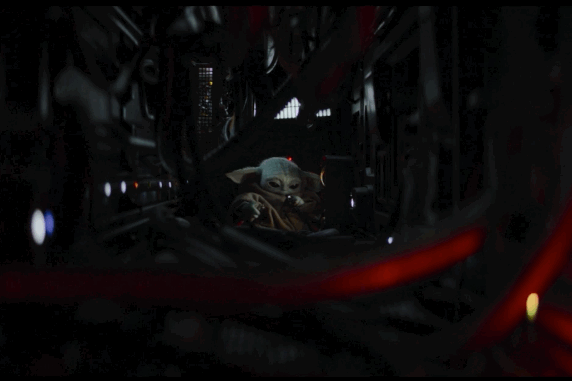
MaximumEnergy
As mentioned earlier, MaximumEnergy only affects the appearance of the weapons gauge.
Rather than just setting MaximumEnergy the same as IntialEnergy, we could adjust it so the weapons gauge shows when you are able to dud certain bullets.
The weapons gauge changes color when you are are below half of MaximumEnergy and again when you are below a quarter of MaximumEnergy.
If the skater ships’ MaximumEnergy was set to four times the damage of an On-Ball Level 1 bullet, the color changes would correspond to the different bullet levels.
The warbird‘s MaximumEnergy could be changed to double the Off-Ball Level 4 bullet, so that it can see easily when it is likely to die off-ball.
The colors for the weapons gauge are adjustable. They are the first three lines of gradient.gif which can be found in \Continuum\graphics\
Rebalancing
I’ve long since thought the bullets system needs an overhaul: many people would like to try static damage. I would at least like to reduce the spread of damage, and remove the very low chance duds.
Energy may have to be tweaked as part of this.
Personally, I like the feel of ?go ice, where Recharge time is much longer. This makes Afterburners feel like a careful investment rather than something to be used excessively.
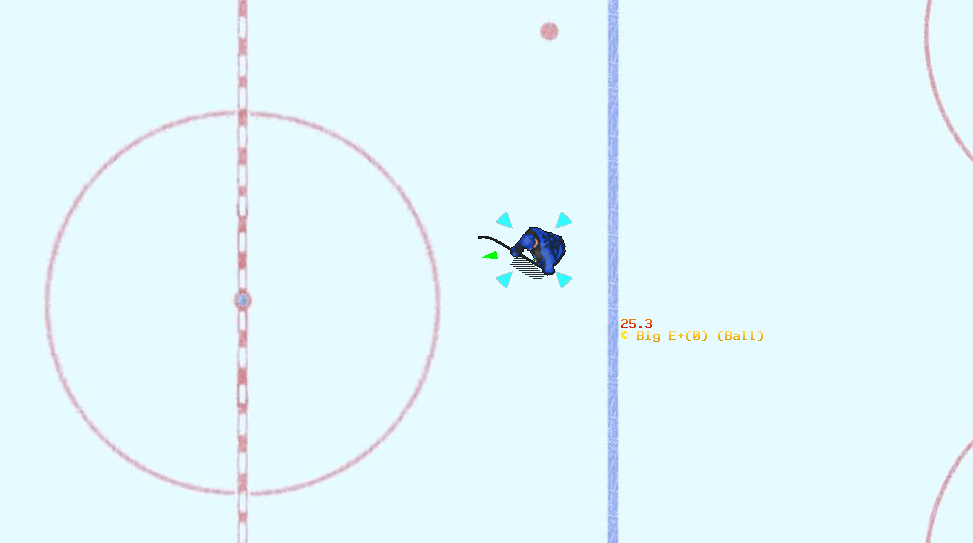
Remove goalie interference
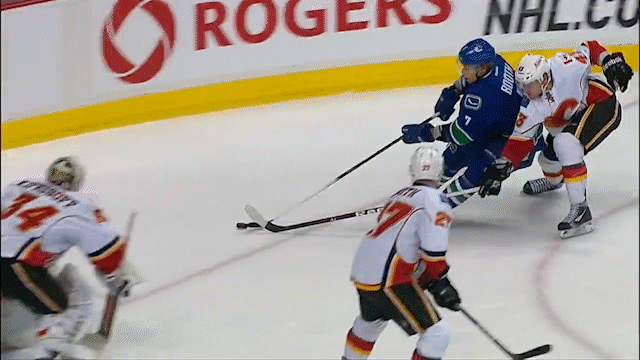
Goalies already have their own Damage profile. We could make it so that goalies suffer much less damage when they don’t have the ball: give them a much higher FlaggerDamagePercent. Although I said earlier that the maximum for most of these settings is 32,767 (215 -1), there is a way to make it even higher: setting it as -1 gives an effective value of 65,536 (216).
Off-ball bullets could then be set to have negligible damage, while still letting the goalie be killed out of the crease when they do have the ball.
Inverted Recharge gimmick
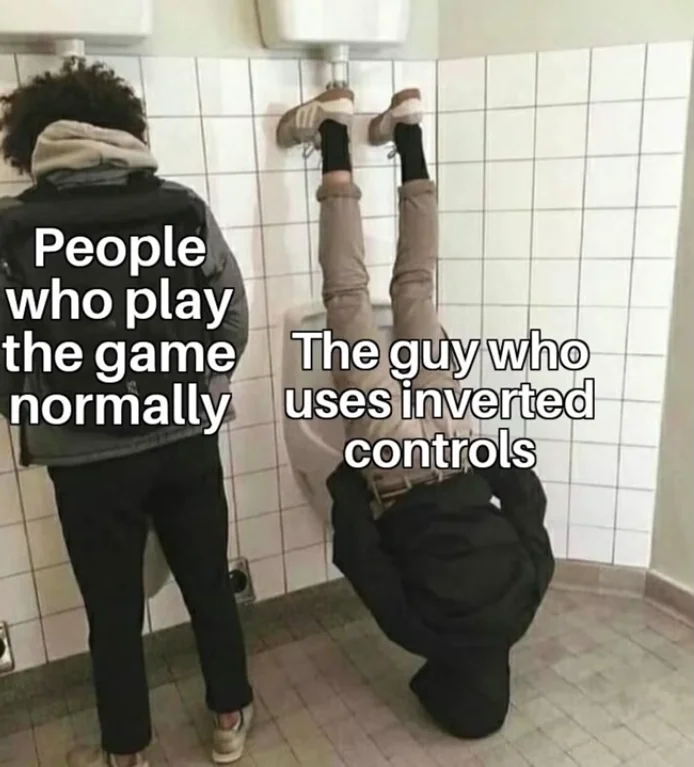
With some trickery, the settings can be inverted so that normal flying costs Energy, and then using Afterburners slows you down and gives you Energy. You would press Shift to recharge instead of for a speed boost. This could be fun for an off-season event, or maybe just a Big E pub night (April fools’ day event?).
Fatigue
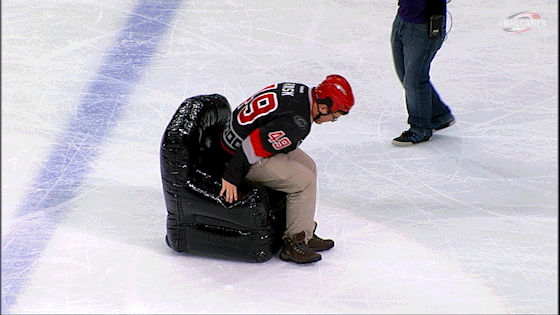
For an off-season event, I’d like to try a fatigue system with periodic negative prizing while a player is on the space ice.
Prizing has been successfully used this Beer Season with the nerfbird.
It could be as simple as progressively lowering Recharge, but could include other settings too.
